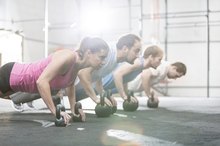Optimum Heart Rate for Building Muscle
Most people consider heart rate monitoring to be most useful for weight loss and cardiovascular fitness. However, monitoring your heart rate is also important when it comes to building muscles. Because your heart rate directly correlates with your workout's intensity, monitoring it is a solid way to find your optimum training zone for building muscle.
Anaerobic Exercise
Anaerobic means without air or oxygen. Anaerobic exercise is physical activity that requires very intense energy output over a relatively short period of time. Examples include weight lifting, sprinting, resistance training and hill climbing. Anaerobic exercise is the most effective type of exercise for building muscle. The optimal heart rate for anaerobic exercise is 80 to 90 percent of your maximum heart rate 2. Your maximum heart rate is equal to 220 minus your age.
- Anaerobic means without air or oxygen.
- The optimal heart rate for anaerobic exercise is 80 to 90 percent of your maximum heart rate 2.
Aerobic Exercise
What Happens to Sugar Levels in the Blood While Fasting?
Learn More
Aerobic exercise means, with air or oxygen. Aerobic exercise involves moderate intensity workouts over a sustained period of time, usually at least 20 minutes. Swimming, cycling and jogging are all examples of aerobic exercise. Aerobic exercise increases your cardiovascular fitness, or your heart's ability to efficiently provide blood and oxygen to your working muscles. As such, aerobic exercise builds your heart muscles and all muscles that are involved in respiration, including your lungs. Building the strength in these muscles is extremely important in order to prevent heart disease and increase overall fitness. Aerobic fitness is found in heart rates that are 50 to 80 percent of your maximum heart rate.
- Aerobic exercise means, with air or oxygen.
- Aerobic exercise increases your cardiovascular fitness, or your heart's ability to efficiently provide blood and oxygen to your working muscles.
Heart Rate Monitor
The difference between intense aerobic exercise and anaerobic exercise to build muscle is not always easy to notice. The best way to monitor the difference is with a quality heart rate monitor. Heart rate monitors are usually worn on the wrist like a watch and use delicate electronic sensors to monitor your heart rate and display it clearly 2. Heart rate monitors can help you track whether you are training in an aerobic or anaerobic heart rate zone, allowing you to build muscle more efficiently.
- The difference between intense aerobic exercise and anaerobic exercise to build muscle is not always easy to notice.
- Heart rate monitors are usually worn on the wrist like a watch and use delicate electronic sensors to monitor your heart rate and display it clearly 2.
Watching Your Diet
How to Lance a Wound
Learn More
When you commit to an exercise program to help build muscle, it is important to maintain your diet. While the right exercise can train your muscles to get stronger, the foods you eat provide the essential building blocks to foster that muscle growth. Maintain a balanced diet that has plenty of proteins in it. Foods like meat, chicken, fish and most beans have high sources of the necessary proteins and amino acids to help you build your muscles in combination with the right workout program.
- When you commit to an exercise program to help build muscle, it is important to maintain your diet.
- Foods like meat, chicken, fish and most beans have high sources of the necessary proteins and amino acids to help you build your muscles in combination with the right workout program.
Related Articles
References
- Medical News Today: What is Exercise? The Benefits of Exercise
- The Walking Site: Your Target Heart Rate
- FoodPyramid.com: MyPyramid
- Stöggl TL, Sperlich B. The training intensity distribution among well-trained and elite endurance athletes. Front Physiol. 2015;6:295. doi:10.3389/fphys.2015.00295
- Target Heart Rate and Estimated Maximum Heart Rate. Centers for Disease Control and Prevention. https://www.cdc.gov/physicalactivity/basics/adults/index.htm.
Writer Bio
Patrick Hutchison has been doing freelance work since 2008. He has worked as a physical therapy aide and as a writer for various websites including Destination Guides and several travel-related companies. Hutchison has a Bachelor of Arts in history and anthropology from the University of Washington.







